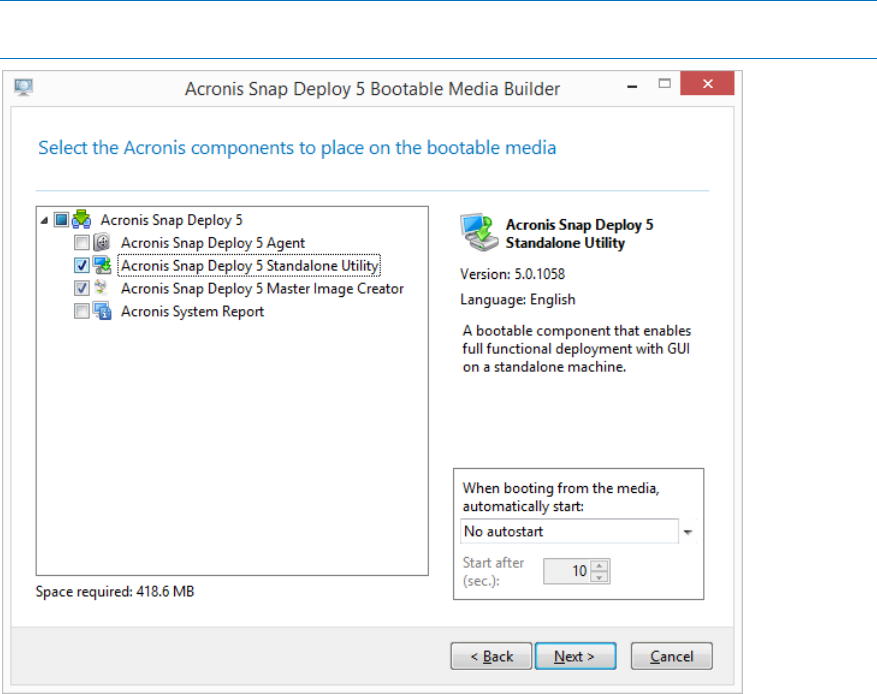User guide
Table Of Contents
- 1 Introducing Acronis Snap Deploy 5
- 1.1 Overview
- 1.2 What's new in Acronis Snap Deploy 5
- 1.3 What you can do with Acronis Snap Deploy 5
- 1.3.1 Taking an image of the master system
- 1.3.2 Deployment to specific machines (immediate, manual, and scheduled deployment)
- 1.3.3 Deployment to any ready machines (event-driven deployment)
- 1.3.4 Stand-alone deployment
- 1.3.5 Deployment with individual deployment settings
- 1.3.6 User-initiated deployment (custom deployment)
- 1.3.7 Deployment of a disk volume and MBR
- 1.3.8 Command-line mode and scripting under WinPE
- 1.4 Features of Acronis Snap Deploy 5
- 1.4.1 List of machines
- 1.4.2 List of deployment tasks
- 1.4.3 Per-deployment licensing
- 1.4.4 Support for the VHD format
- 1.4.5 Graphical user interface in WinPE
- 1.4.6 E-mail notifications about deployment
- 1.4.7 Compatibility with images created by other Acronis products
- 1.4.8 Support for multiple network adapters
- 1.4.9 Multicast TTL and network bandwidth throttling
- 1.4.10 Falling back to unicast
- 1.4.11 Encrypted communication
- 1.4.12 Password protection
- 1.5 Supported operating systems for imaging and deployment
- 1.6 Licensing policy
- 1.7 Upgrading to Acronis Snap Deploy 5
- 1.8 Technical Support
- 2 Understanding Acronis Snap Deploy 5
- 3 Getting started with Acronis Snap Deploy 5
- 4 Installation of Acronis Snap Deploy 5
- 4.1 Supported operating systems
- 4.2 System requirements
- 4.3 Used ports and IP addresses
- 4.4 Typical installation
- 4.5 Custom installation
- 4.5.1 Installation procedure
- 4.5.2 Common installation configurations
- 4.5.3 Installation of components
- 4.5.3.1 Installation of Acronis Snap Deploy 5 Management Console
- 4.5.3.2 Installation of Acronis Snap Deploy 5 License Server
- 4.5.3.3 Installation of Acronis Snap Deploy 5 OS Deploy Server
- 4.5.3.4 Installation of Acronis PXE Server
- 4.5.3.5 Installation of Acronis Wake-on-LAN Proxy
- 4.5.3.6 Installation of Acronis Snap Deploy 5 Management Agent
- 4.6 Other ways of installation
- 4.7 Upgrading Acronis Snap Deploy 5
- 4.8 Uninstalling Acronis Snap Deploy 5
- 5 Using Acronis Snap Deploy 5 Management Console
- 6 Using Acronis Snap Deploy 5 License Server
- 7 Deployment tools
- 8 Creating a master image
- 9 Validating a master image
- 10 Deploying a master image
- 10.1 Files supported as master images
- 10.2 Licenses for deployment
- 10.3 Deployment templates
- 10.4 Deployment through a deployment task
- 10.5 Stand-alone deployment
- 10.6 User-initiated deployment (custom deployment)
- 10.7 Deploying BIOS-based systems to UEFI-based and vice versa
- 11 Managing the list of machines (the Machines view)
- 12 Individual deployment settings
- 13 Managing deployment tasks (the Deployment tasks view)
- 14 Command-line mode and scripting under WinPE
- 15 Collecting system information

116 Copyright © Acronis International GmbH, 2002-2014
If Acronis Wake-on-LAN Proxy is installed in that subnet, forward the TCP and UDP ports
9876 to the machine with the Wake-on-LAN proxy.
If Acronis PXE Server is installed in that subnet, forward UDP ports 67, 68, and 69 to the
machine with the PXE server.
2. When creating the deployment task, specify the IP address of the NAT device when asked about
the address of the PXE server and/or of the Wake-on-LAN proxy.
Even after you configure the NAT device this way, you might still receive inconsistent information
about the deployment progress for each machine.
10.5 Stand-alone deployment
Stand-alone deployment is deployment to a machine that is isolated from the network or included in
a network without Acronis Snap Deploy 5 infrastructure (to be exact, without Acronis Snap Deploy 5
OS Deploy Server). Stand-alone deployment is performed locally by using the bootable component
called Acronis Snap Deploy 5 Standalone Utility.
To perform a stand-alone deployment
1. Install Acronis Snap Deploy 5 Management Console.
2. Create an Acronis bootable media (p. 65) with Acronis Snap Deploy 5 Master Image Creator and
Acronis Snap Deploy 5 Standalone Utility.
Note: Acronis Snap Deploy 5 Standalone Utility can be placed on a physical media only. This component is
not designed to boot from a PXE server or from a WinPE-based bootable media.
The Acronis stand-alone components to be placed on the bootable media
3. Configure the master system.
4. Boot the master system into Acronis Snap Deploy 5 Master Image Creator. Create an image of
the master system and save it to a network folder, detachable media, or removable media. You










